 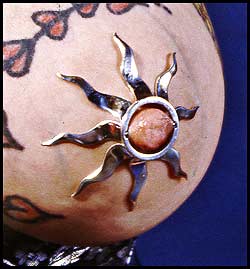 When Janet Jackson flashed her breast at the 2004 SuperBowl creating a firestorm of controversy, she was wearing a Gauntlet nipple shield. The sunburst design was one I created in the mid 70s. When you pay a visit to your local piercer and look at the tremendous variety of jewelry in their display case, it’s easy to assume it’s always been that way. What’s difficult to believe is that before Gauntlet, piercing enthusiasts were making do with earrings and all kinds of improvised contrivances. Although I’m always reluctant to blow my own horn, the truth is that I was personally responsible for many of the jewelry designs and piercing innovations most people take for granted.
Although Gauntlet officially became a business in November of 1975, it took nearly nine months before things began to come together enough for me to issue Gauntlet’s first jewelry “Folio.” To call it a catalog would be stretching things. It was simply a legal sized piece of heavy paper printed on both sides and folded into quarters. But to the best of my knowledge it was the first time any collection of body jewelry designs had ever been offered for sale to the public. Despite Doug’s financial help, my budget was still very lean. I had little knowledge of photography, especially taking pictures of jewelry, which is an art unto itself. Since I couldn’t afford to hire a professional photographer and printing photographs would have been more costly, I chose to illustrate the first brochure myself with line drawings. In these days of desktop publishing, younger people have no concept of what was involved to produce printed materials before the advent of the home computer. The process was in constant evolution, but in the mid 70s a common way was to take the copy to a local printer. There someone would type it into a special IBM Selectric typewriter — anyone remember typewriters? — equipped with memory. At the push of a button the text would then be printed onto special paper that would later be cut up and pasted by hand into the final layout. All very primitive by today’s standards. Headlines were often produced separately using fonts that were on a strip of film. Each letter was exposed onto light sensitive paper and when finished, processed in photo chemicals. As an alternative you could do as I did and use rubdown lettering for headlines. I was still groping my way. It took time to design and “test drive” the nearly dozen items that appeared in the first brochure. As mentioned in an earlier column, my first design was the nipple retainer. The bead ring, a scaled up version of a fairly common earring design, followed this. In the months and years to come, jewelry designs were always being developed and refined. Some became classics that are still being reproduced today; some were consigned almost immediately to history. Others lasted for a while, eventually fading into obscurity for lack of interest by customers. Still others ended up on the scrap heap because experience proved a particular design was no longer appropriate. Regardless of their longevity, many of them have an interesting story. For a great many years the standard bead ring with the attached ball was Gauntlet’s bread and butter. But some members of the T&P group, and others, wanted a design that appeared to be continuous. Had it been practical they would have been quite happy to have the rings permanently soldered shut. One of Gauntlet’s early competitors was a short-lived business called Whatever Rings. It was run by a couple of gay guys who were heavy S/M players. They operated out of their West Hollywood apartment and solicited business through ads in the local gay press. The business was primarily a means for them to entice men into an S/M scene. The “jewelry” sold by Whatever Rings consisted of gold wire formed into simple gold rings. There was no closure. While they might look nice, I personally considered them impractical if not dangerous. From experiments I had done I knew it was difficult to get the ends to line up perfectly, particularly after the ring had been inserted into a piercing. This could mean discomfort if the gap rotated inside the piercing. The gap, no matter how small, could also trap debris and quickly become a breeding ground for germs that could lead to infection in a fresh piercing. 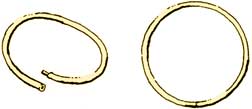 The “Seamless” Ring. Still, some people liked the look and insisted they wanted it. So I tried to make something at least a little more practical. I called it a “Seamless” Ring. It still had the small gap, but I perfected a way of crafting a pin coupling which, if nothing else would keep the ends in alignment. To minimize the risk of infection, I insisted that customers wait until their piercings had healed before wearing this type of jewelry. Unfortunately one of my customers discovered the shortcomings of the design not long after I’d inserted them into his nipple piercings. His name was Alden, and he was part of the T&P group. He also enjoyed rough sex play. Early one Monday morning he showed up on my doorstep. It was obvious something was wrong. Apparently he’d gotten into some pretty heavy action on Saturday night. Someone he was playing with got a little too rough with his nipple rings and one of them had sprung open inside the piercing. He couldn’t rotate the ring or remove it and was in great discomfort. I had to open the ring with a pair of ring expanding pliers in order to remove it. After that he understood the benefits of wearing a ring with a closure especially if he planned on a rough night. 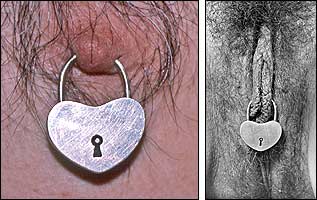 Handcrafted jewelry locks
The S/M B/D community were a significant component of my early clientele. A very common request was for a piece of jewelry that could be permanently installed. For most people this was nothing more than a fantasy. They still wanted something that could be removed whenever they wished it. So I set out to see what I could do with locks. Back when I’d lived in Denver I’d wanted to put a lock in my ear piercing. In the early 70s it was uncommon for a man to have an ear piercing at all, and stretched piercings were something you only saw in National Geographic. There was no way I could see to get a lock through my ear. I had some basic jewelry making tools and was easily able to get some silver sheet and wire. Using these I constructed a crude working lock. This design with its broken shackle and another with a solid one, made their way into my first jewelry brochure. Unfortunately these handcrafted locks were never practical. If worn on any semi-permanent basis, they would soon become bound up with disgusting gunk and nearly impossible to open. I attempted unsuccessfully to remedy the situation by replacing the tiny spring with a pad of silicone rubber. Making the locks became a job I dreaded. They involved a lot of work that seemed wasted because of the inherent problems. By the time I issued my second brochure I’d dropped the design with the broken shackle replacing it with a simulated lock that needed no key and had no mechanism to get fowled up. Eventually I discontinued locks altogether. 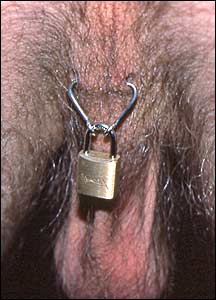 A jewelry prototype that never made it into production. Other attempts at permanently installable jewelry were made, such as a triangular ring that had two eyes, one threaded, that could be closed with a small lock. Since they weren’t waterproof, even commercially manufactured locks weren’t practical for long term wear. There were a few hardcore souls who seriously did want something permanent. Soldering, of course, was out of the question. I did find one successful solution. The balls on our standard bead ring were hollow. I would cut a groove around the end of the ring that went inside the ball and fill it with epoxy. When the ring was closed the cement would be forced into the groove where it would set and make the ring impossible to open. 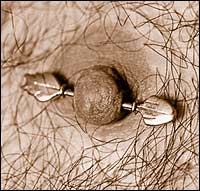 Arrow of Eros
I’ve written previously about the early development of barbells. Once I’d mastered the manufacturing problems it seemed natural to design some variations. The first was what I called the Arrow of Eros. To maximize comfort I didn’t want the head to be sharp, so I modified the shape to something like a Native American arrowhead. The two ends were forged out of metal. These were then taken to an engraver who cut the details. From there rubber molds were made so that the pieces could be cast. Though never a best selling design it nonetheless remained in the Gauntlet line for over twenty years.
Other barbell variations followed. The second brochure included what I called Jeweled Studs. These had semiprecious stone beads set in pronged pearl settings. They were never very popular and in time disappeared from the line. Over the years many other variations were introduced. None of them were ever as popular as the initial one with round balls which made it much more versatile. 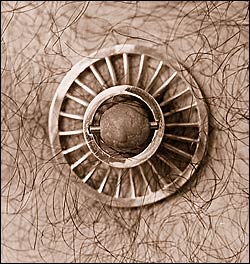 An early nipple shield design. To the best of my knowledge the concept of the nipple shield was original with Gauntlet. The idea was to offer a design that was more decorative and would appeal especially (though not exclusively) to women. As a gay man I still had a lot to learn about female anatomy because many of the first designs had an inside diameter that wouldn’t fit many female nipples! At one point I contemplated using spring-loaded watchband pins to hold the shields on, but this proved impractical and unnecessary. The tension of the stretched nipple was sufficient to hold the shield in place. S/M also had an influence especially on one particular design. Even in the early days there were people into play piercing. For them I came up with something like a spoked wheel which had a little more depth. This drew the nipple out so that hypodermic needles could be inserted through the spokes. 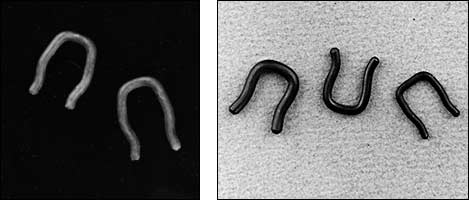 The septum retainer was a major breakthrough. (Left: the original septum retainer, right: niobium retainers) It might not exactly qualify as jewelry, but another early Gauntlet innovation was the septum retainer. You might be able to go to work with a septum piercing today, but in the 1970s it would have been unthinkable. Still, there were people who passionately wanted the piercing. That was my inspiration. The first septum retainers were made of oxidized copper wire covered with Teflon tubing. They were virtually invisible. Eventually they when replaced by an anodized niobium version which is offered by a number of manufacturers today. 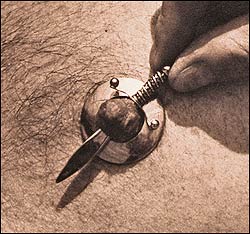 Custom nipple jewelry.
Especially in the early years when I made almost all the jewelry myself, I had a number of clients who asked me to create something custom just for them. One of the first was Jim A. He wanted a simple gold nipple shield that would be held in place by a gold sword. The blade was made from quarter inch tubing that was pounded flat on one end, soldered shut, and shaped. A brass plug was soldered into the other end. This was drilled and tapped. The handle was wrapped with wire and a bit of flattened chain and ornamented with gold balls. Jim stretched his piercings up to a quarter inch just so he could wear his new jewelry. 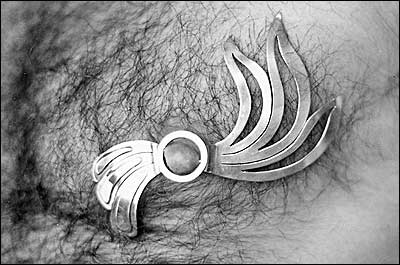 Another man wanted a custom nipple shield. He told me he had a thing for feathers and wanted this reflected in the design. It was something of a challenge. Not wanting it to be big or heavy, the feathers have large cutouts and are counterbalanced by complementary shapes that are weighted with extra metal. He seemed pleased. 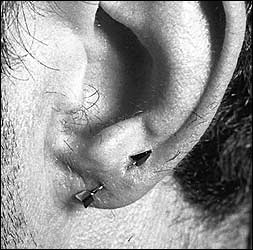 Multiple ear piercings weren’t exactly common in the early Gauntlet days. This man came in with two ear piercings and wanted an arrow made that would go through both of them. Here’s the result. The post was not straight but shaped to accommodate the piercings. The arrowhead was drilled and tapped to screw onto the post. It was so tiny that the only way I was able to screw it on was to use a pencil eraser with a slit cut in it to hold onto the arrowhead. One of my more colorful clients was a Hungarian doctor who showed up on my doorstep one day. I was still working out of the house at the time, and he’d been referred to me by the Pleasure Chest, a sex shop that had recently opened in West Hollywood. Dr. C was impeccably dressed in a suit and tie and had the bearing of a European gentleman. He explained that he wanted a frenum piercing. This was accomplished without a great deal of fuss. I must confess I was a bit more nervous that usual. Although clean, the house and furniture were shabby. He was, after all, a doctor, and I was concerned that he would be uncomfortable being pierced in such an environment. Still, I brought out a clean bath towel and spread it on the couch for him to lie on. I laid out the bagged and sterilized equipment on a stainless tray. When I was finished he complemented me my technique as well as the cleanliness that I observed. It was a particular validation coming from him. 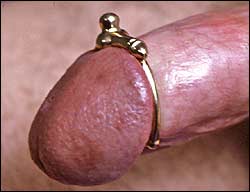 With casual European sophistication the good doctor told me that he and his wife were no longer sexually active. He had a young girlfriend who he particularly wanted to keep satisfied. To that end he commissioned me to make a cast gold frenum ring that would incorporate two penises and a ball on top that would stimulate her clitoris during intercourse. He quipped that he wanted to penetrate her with three penises. Dr. C was quite happy with the finished piece of jewelry. Unfortunately he didn’t feel comfortable wearing it all the time, especially at the health club. Consequently he took it on and off frequently. Eventually the post would break off, and he would bring it to me for repair. The last time this happened he brought it in and chatted amiably about what a wonderful device it was. I told him how long it would take for the repair, and everything seemed satisfactory. I never saw him again. Whatever happened to him I never found out. After holding onto the piece of jewelry for several years, I eventually sold it. 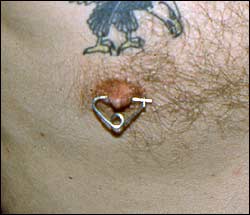 For the first several years all my jewelry was either gold or a mixture of gold and silver. Although many clients wanted stainless steel I didn’t know how to make jewelry from that particular metal. Early on I attempted a design I called a triangular safety pin made out of stainless steel wire. It was abandoned fairly quickly because the hook closure tended to snag on clothes and bedding. Gauntlet’s transition to stainless production was not an easy one. I resisted as long as possible and finally gave in because the price of gold had begun to rise alarmingly. The challenges were many. First and foremost it was necessary to determine which of the hundreds of stainless steel alloys was appropriate for inserting into the body. The best information I was able to gather was that it needed to be low-carbon and nickel-free. At various times we made jewelry of 304 and 316 stainless. The industry standard today is 316L. Then there was the matter of gauge. The standard gauge system used for steel wire is different from that used for gold and silver, so for the sake of consistency it was necessary to have all the stainless steel wire custom produced. The coils of wire arrived from the mill and I discovered that it was too stiff to be easily shaped. Gold and silver can be softened, a process called annealing, quite easily by heating them red hot and quenching them immediately in cold water. If you do this to steel you only make it harder. The only way to get the wire soft was to send it out and have it professionally heat-treated. At first I tried unsuccessfully to apply gold fabrication techniques to stainless steel. The results were disappointing to say the least. Eventually I found a company that was able to silver solder drilled stainless balls onto stainless steel rings and then electropolish them. For some reason the quality of the electropolishing was not reliable. Sometimes the surface was not mirror bright and on occasion the process was overdone and the rings came back measurably thinner than they should have been. Many of these problems could have been eliminated had I not been convinced that the captive bead ring design was unsatisfactory. As someone who continually thought of piercing as an adjunct to sex play, I felt the ball could too easily come loose and get lost. I couldn’t imagine many people wanting to search for a ball lost inside a body cavity. Stainless steel barbells presented their own difficulties. There was no way to produce them in house, so I went looking for a machinist to do the job for us. Part of the problem was that I had no idea how to locate the right person. The results were less than satisfactory. The first order of barbells I had made should never have seen the light of day much less been offered for sale. The machinist was unequipped to produce a stud with an internally threaded post. I ended up settling for externally threaded studs, and to say that I was frustrated is putting it mildly. In order to insert them without causing discomfort or damage to the individual, the externally threaded post first had to be dipped in melted wax. It was a compromise I hated. When the stock began running low I started looking for another machinist and finally found one who was able to produce an internally threaded barbell stud. Unfortunately that was only half the challenge. The other was to produce a ball with male thread attached. The machinist produced short threaded pins that had to be secured into drilled and threaded balls. We tried various kinds of cement without success and ended up having to silver solder them. It was a solution, although again less than 100% satisfactory. On occasion clients would ask why Gauntlet’s stainless steel jewelry was so expensive. I always told them that they could buy a nut and bolt at the hardware store for pennies because they were manufactured by the millions. At that time there simply weren’t enough people who needed stainless steel body jewelry to mass produce it like hardware. All that has certainly changed. 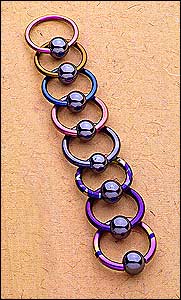 Niobium body jewelry, another Gauntlet innovation, is wildly popular today and available almost everywhere. In the early 80s craftspeople were beginning to make regular jewelry from anodized niobium. It was incredibly beautiful, and when I learned just how inert the metal was, I realized its great potential. The material was fairly inexpensive and could be anodized in an array of bright colors. It took some effort to perfect the technique. The anodizing process required that the metal piece be attached to an electrode and submerged in a solution mostly of water. The more oxygen the solution could make available to the process, the better the results. Different craftspeople had their own secret formulas. I heard of someone who used Coca-Cola. What seemed to work best for me was a solution containing non-chlorine bleach. Since there is no practical way to solder niobium, I finally was forced to embrace the captive bead ring. From then on it became part of Gauntlet’s jewelry line. It’s been almost thirty years since I started Gauntlet, but the ideas and innovations that it pioneered are very much with us today. I often wish I were receiving royalties. I’d be a very rich man. Next: The First Piercing Store Opens its Doors
Copyright © 2004 BMEzine.com LLC. Requests to publish full, edited, or shortened versions must be confirmed in writing. For bibliographical purposes this article was first published May 18th, 2004 by BMEzine.com LLC in Toronto, Ontario, Canada
|
 |
|||||||||||||||||
Post navigation
6 thoughts on “Gauntlet’s Jewelry Design Legacy [Running The Gauntlet – By Jim Ward]”
 BME/News and Modblog highlight only a small fraction of what BME has to offer. Take our free tour and subscribe to BME for access to over 3 million body modification related photos, videos, and stories.
BME/News and Modblog highlight only a small fraction of what BME has to offer. Take our free tour and subscribe to BME for access to over 3 million body modification related photos, videos, and stories.









I have three stainless steel bead rings that I bought at the Gauntlet in San Francisco in 1992. They’ve never been removed and they’ve never dulled. Do you know where to find a source? I’m looking to find a match for one I wear so I can have a pair. All I can find are captive bead rings. Thanks.
I have three stainless steel bead rings that I bought at the Gauntlet in San Francisco in 1992. They’ve never been removed and they’ve never dulled. Do you know where to find a source? I’m looking to find a match for one I wear so I can have a pair. All I can find are captive bead rings. Thanks.
It’s hard to talk about whether or not this is very good, nevertheless only time will tell, as with most superb design.
It’s hard to talk about whether or not this is very good, nevertheless only time will tell, as with most superb design.
I suppose it’s a good sign that the negative comments were actually few enough that it seemed more like griping about tiny details. You can buy 3D Blue-ray players at merchant stores such as Amazon or offline at major retail and electronics stores near you. Make sure to compare like specs for accurate comparisons. There are many options in camcorder types; you could buy an analogue camcorder or a digital camcorder.
I suppose it’s a good sign that the negative comments were actually few enough that it seemed more like griping about tiny details. You can buy 3D Blue-ray players at merchant stores such as Amazon or offline at major retail and electronics stores near you. Make sure to compare like specs for accurate comparisons. There are many options in camcorder types; you could buy an analogue camcorder or a digital camcorder.